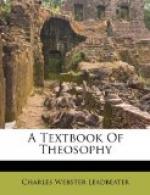Group-souls at any level or at all levels arrange themselves into seven great types, according to the Minister of the Deity through whom their life has poured forth. These types are clearly distinguishable in all the kingdoms, and the successive forms taken by any one of them form a connected series, so that animals, vegetables, minerals and the varieties of the elemental creatures may all be arranged into seven great groups, and the life coming along one of those lines will not diverge into any of the others.
No detailed list has yet been made of the animals, plants or minerals from this point of view; but it is certain that the life which is found ensouling a mineral of a particular type will never vivify a mineral of any other type than its own, though within that type it may vary. When it passes on to the vegetable and animal kingdoms it will inhabit vegetables and animals of that type and of no other; and when it eventually reaches humanity it will individualize into men of that type and of no other.
The method of individualization is the raising of the soul of a particular animal to a level so much higher than that attained by its group-soul that it can no longer return to the latter. This cannot be done with any animal, but only with those whose brain is developed to a certain level, and the method usually adopted to acquire such mental development is to bring the animal into close contact with man. Individualization, therefore, is possible only for domestic animals, and only for certain kinds even of those. At the head of each of the seven types stands one kind of domestic animal—the dog for one, the cat for another, the elephant for a third, the monkey for a fourth, and so on. The wild animals can all be arranged on seven lines leading up to the domestic animals; for example, the fox and the wolf are obviously on the same line with the dog, while the lion, the tiger and the leopard equally obviously lead up to the domestic cat; so that the group-soul animating a hundred lions mentioned some time ago might at a later stage of its evolution have divided into, let us say, five group-souls each animating twenty cats.
The life-wave spends a long period of time in each kingdom; we are now only a little past the middle of such an aeon, and consequently the conditions are not favourable for the achievement of that individualization which normally comes only at the end of a period. Rare instances of such attainment may occasionally be observed on the part of some animal much in advance of the average. Close association with man is necessary to produce this result. The animal if kindly treated develops devoted affection for his human friend, and also unfolds his intellectual powers in trying to understand that friend and to anticipate his wishes. In addition to this, the emotions and the thoughts of the man act constantly upon those of the animal, and tend to raise him to a higher level both emotionally and intellectually. Under favourable circumstances this development may proceed so far as to raise the animal altogether out of touch with the group to which he belongs, so that his fragment of a group-soul becomes capable of responding to the outpouring which comes from the First Aspect of the Deity.




